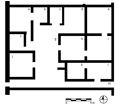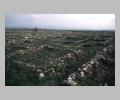| Context: | Olynthus |
| Type: | House |
| Summary: | Irregularly planned house near the Agora of Olynthus |
| Date: | ca. 432 BC - ca. 348 BC |
| Dimensions: | Ca. 17.7 x 21.3 m |
| Period: | Classical/Late Clas. |
Plan:
Rather irregular plan with rooms ranged irregularly around a small courtyard; built against the western fortification wall of the city.
Date Description:
Not built before 432 BC, when this part of Olynthus was planned and laid out; destroyed by Philip II in 348 BC.
Other Notes:
The southern three houses in Row A, houses A 11 - A 13, are irregular in plan but rather similar to one another. Like the other houses in Row A, house A 11 is larger than the average Olynthian house, measuring 17.7 x 21.3 m, including the alley between it and A 12, and is built against the west fortification wall of the city. It is irregular in plan, consisting of a series of architecturally unspecialized rooms arranged around a courtyard (g), with no kitchen, andron, or other specialized spaces. The house has no pastas; all of its rooms seem fairly enclosed. Half of the rooms are roughly the same size: a, d, e, h, i and j are all about 4.9 x 4.5 m; the other rooms somewhat smaller. The rooms are arranged in a more hierarchical fashion than those of "typical" houses: for instance, the only entrance into room e is through rooms h and i, and the only entrance into room k is through l. The walls are unplastered and unpainted; the floors all earth. The entrance to the house is not certain, since its east wall was not preserved above its foundations, but was probably through the "alley," room m. There is no evidence for a second floor. The house thus shows a less organized and "typical" architectural arrangement of space than the more regular houses at Olynthus.
To judge from the distribution of artifacts in the rooms, the use of space was less organized as well. Some activities are restricted to specific rooms, for instance weaving in room d, where 25 loomweights were found. But other types of artifacts and activities seem distributed all over the house. The rooms in the northwestern part of the house, for instance, contained storage amphoras in roughly equal numbers: five rooms (c, d, e, h, and k) each contained two amphoras, while a sixth (i) contained four. Whatever these amphoras were used to store, no single space seems to have been designated for storage, but instead that function was distributed through many rooms. Likewise, no room has a great concentration of vases: tablewares are found, in moderate numbers, in rooms e, f, g, h, k, l and m, but there is no specific room where household equipment was stored, as there was, for instance, in house
Other notable artifacts in the house include a lower grindstone which was found in room h; "pithos lids or table tops" in e and h; a louter base in b and a louter and base in j. And in the western part of the court was found a cache of at least eight plastic vases and terracottas, including a head of Dionysus and a faun head, two male heads, a female mask, and three female figures. Such caches are not uncommon in the courts and porticoes of houses at Olynthus. Finally, this house, like its neighbors A 12 and A 13, contained a large number of coins. Room j had a hoard of 10 bronze coins, and the whole house contained some 96 coins, including six silver coins; this is second only to house
A sales inscription (or, more precisely, an inscription recording a "sale on condition that the seller may release the property from the buyer's claim on it," or a "security in the form of a conditional sale," one of the many roundabout ways the Greeks negotiated loans) was found in the courtyard, recording that this house was used as security on a 2000 dr. loan to Archidamus, son of Metrichus. The inscription lists the neighbors as Polyxenus the son of Telagrus and Pythion, the son of Diodorus; Polyxenus and Pythion also served as witnesses to the transaction. It is notable that among the magistrates of the Chalcidic mint were men named Archidamus and Polyxenus. If these are the same men as those named in this inscription, it is interesting that they were neighbors, and that these prominent men would own such irregular and architecturally undistinguished houses.
Sources Used:

